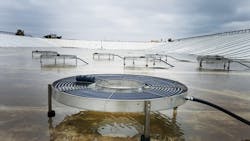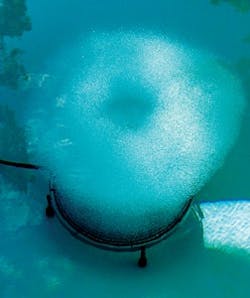About the author: Robby Schultheis is design engineer for Air Diffusion Systems. Schultheis can be reached at [email protected] or 847.782.0044.
Founded in 1887, the town of Culbertson, Mont., is located in the northeastern part of the state, just 60 miles south of the Canadian border. Culbertson is home to approximately 716 residents and 50 businesses that require an effective wastewater treatment system that complies with state and federal regulations.
Previously, the town utilized a facultative lagoon system without mixing or aeration. These existing lagoons exhibited multiple deficiencies, including unpermitted discharges, excessive vegetation, excessive sludge accumulation, and leakage rates that exceeded allowable limits and had reached their maximum capacity, which prevented future sewer hookups and growth for the town. The Montana Department of Environmental Quality (DEQ) issued an administrative order of consent to ensure that the town’s wastewater treatment system would be upgraded to comply with its newly issued Montana Pollutant Discharge Elimination System (MPDES) Permit. The town analyzed multiple alternatives, which included land application to a local farmer’s field and constructing aerated lagoons with a direct discharge to the Missouri River to meet the Montana DEQ standards.
Before Air Diffusion Systems (ADS) installed the wastewater aeration system in 2016, Culbertson’s wastewater treatment facility would likely have exceeded the limits of 30 mg/L limit for biochemical oxygen demand (BOD) and 30 mg/L for total suspended solids (TSS). Prior to the system upgrades, the town did not have a discharge permit and was not required to perform effluent water quality testing.
Drew Pearson at WWC Eng. contacted ADS as a potential supplier to meet the wastewater treatment needs of this small community without significant expense. Funding for the project was provided by the U.S. Department of Agriculture Rural Development (RD), which requires free and open competition for major system components, such as aeration.
A request for proposals (RFP) for the aeration equipment was advertised to satisfy this funding requirement. Proposals from the RFP were scored and ADS ranked at the top. Results from the RFP scoring were reviewed by the town and RD, which concurred with the scoring, and ADS was selected as the project’s aeration vendor.
The disk modules are connected to approximately 7,000 sq ft of self-sink aeration tubing and paired with two 30-hp power blowers.
Aeration Upgrade
Culbertson’s wastewater treatment system is permitted to treat 0.2 million gal per day on average, with an influent loading of 240 mg/L for BOD and 264 mg/L for TSS concentrations.
In April 2016, ADS installed 45 LWA-1.5 disk modules connected to approximately 7,000 ft of self-sink aeration tubing to provide oxygen and mixing to the wastewater treatment plant’s three lagoons.
The aeration system was paired with two 30-hp blowers to deliver 345 cu ft per minute of filtered oil-free air. One blower is designated as a standby while the other is running. After the blower manifold piping, two header pipes run along each side of the lagoons for the individual feeder tubing connections to the disk modules and aeration tubing. The aeration system for Culbertson’s wastewater treatment plant is designed with a five-year product and treatment warranty.
A Cost-Effective Solution
For more than 50 years, ADS has been treating water and wastewater naturally by providing bottom “oxygen.” After discovering the benefits of using subsurface fine-bubble aeration, J. Nelson Hinde of Hinde Eng. was one of the pioneers of aeration treatment. He engineered a process to improve wastewater treatment by restoring bottom oxygen levels capable of supporting aerobic organisms to convert unwanted wastes.
ADS fine-bubble aeration is designed to provide optimal oxygenation and mixing without creating turbulence or resuspending bottom sludge and sediment. It promotes the settling of solids and wastes to the bottom of the water column where they are internally stored and digested.
The system is designed for ease of maintenance, as the fine-bubble diffusers can be easily accessed and serviced. The aerated lagoon systems are designed for a 20-year service life when properly maintained.
This wastewater aeration system also offers energy savings. The actual brake horsepower (BHP) per design population is less than 0.01 BHP. At 10 cents per kilowatt hour, each person pays less than two cents per day. Since the installation of the fine-bubble diffusers, Culbertson’s wastewater treatment lagoons are now capable of meeting TSS and BOD discharge limits year-round.

